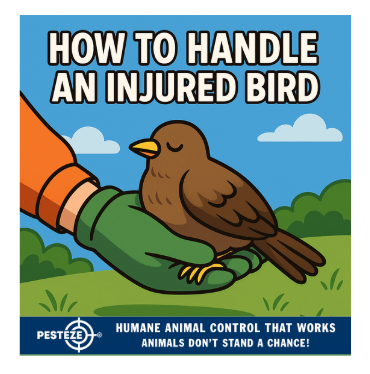HOW TO HANDLE AN INJURED BIRD

HOW TO HANDLE AN INJURED BIRD
SUMMARY
Finding an injured bird can be emotional, but handling it incorrectly may cause more harm. This guide explains safe and humane steps to protect both you and the bird until professional help is available.
FEATURES
-
Observe first: Determine if the bird truly needs help.
-
Protect yourself: Wear gloves to avoid injury or disease.
-
Minimize stress: Keep the bird in a quiet, dark, safe space.
-
Do not feed or water: Avoid giving food or liquids.
-
Use safe containment: Place in a ventilated box lined with cloth.
-
Contact experts: Reach out to wildlife rehabilitators promptly.
GUIDE DESCRIPTION
Birds are delicate creatures, and encountering one that is hurt can leave you wondering how to help. Knowing how to handle an injured bird ensures that you provide comfort without causing further harm.
The first step is to observe carefully. Sometimes, a bird that seems injured may only be stunned—for example, after colliding with a window. Give the bird a few minutes of quiet observation to see if it recovers on its own before intervening.
If intervention is necessary, protect yourself first. Even small birds may bite, scratch, or carry parasites. Wearing gloves reduces the risk of injury and exposure to potential diseases. Approach the bird slowly and calmly to avoid panic.
Next, focus on minimizing stress. Birds are easily overwhelmed when handled, which can worsen their condition. Place the bird in a dark, quiet environment to help it calm down. Avoid unnecessary touching, noise, or activity around the bird.
It’s important to remember: do not feed or give water. While it may seem like a kind gesture, improper feeding can choke or harm the bird. Injured birds need professional care, not improvised food or water.
For safe transportation, contain the bird properly. Use a ventilated cardboard box lined with a soft cloth or paper towel. Avoid wire cages, as birds can injure themselves trying to escape. Close the box securely but ensure airflow, and keep it in a warm, quiet place.
The most critical step is to contact professionals. Wildlife rehabilitators, animal shelters, or veterinarians trained in avian care can provide the medical attention the bird needs. Many regions have hotlines or organizations dedicated to helping wildlife—look them up as soon as possible.
By observing, protecting, reducing stress, avoiding food or water, and contacting experts, you give the injured bird the best chance at recovery. With care and quick action, you may help it safely return to the wild.
- Saneeth Thota


Comments 0